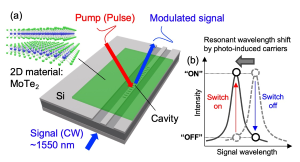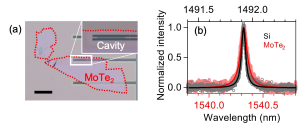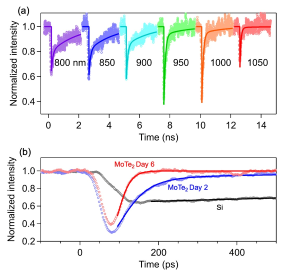Research:Hybrid silicon all-optical switching devices integrated with 2D material
As the demand for faster and more energy-efficient optical communications increases, all-optical switching, which handles the routing and modulation of optical signals, plays a crucial role in photonic integrated circuits (PICs). Conventional all-optical switching devices based on silicon substrates allow for seamless integration with other electronic and optical devices. However, the carrier lifetime of silicon imposes limitations on response speed, constraining both speed and efficiency. In contrast, two-dimensional (2D) materials such as transition metal dichalcogenides exhibit unique optoelectronic properties, including rapid carrier recombination and strong light-matter interactions, making them promising candidates for next-generation photonic devices. This study aims to overcome the performance limitations of all-optical switching by leveraging a hybrid structure that combines silicon with 2D materials, thereby harnessing the advantages of silicon as a platform for PICs. (Fig. 1)

We developed a hybrid all-optical switching device that integrates a 2D semiconductor, molybdenum ditelluride (MoTe₂), with a silicon nanocavity. This device achieves switching by leveraging the refractive index change in MoTe₂ induced by optical excitation (Fig. 1(b)). To enable efficient light-matter interaction, we designed a photonic crystal nanobeam cavity and transferred MoTe₂ flakes onto it (Fig. 2(a)). By irradiating MoTe₂ with optical pulses, the resonant wavelength of the cavity shifts, enabling the switching operation.

The cavity integrated with MoTe₂ retained a high Q-factor necessary for low-energy operation (Fig. 2(b)). Additionally, it was observed that defects introduced by the degradation of MoTe₂ promoted non-radiative recombination, further enhancing the switching speed. By tuning the wavelengths of the signal and pump, an optimal modulation contrast was achieved, with the optimal pump wavelength determined to be approximately 1000 nm (Fig. 3(a)). Experimental results demonstrated high-speed (tens of picoseconds) and low-energy (hundreds of femtojoules) switching (Fig. 3(b)). Compared to devices based solely on silicon, this hybrid switch exhibited significantly improved switching speeds and reduced energy consumption.

This hybrid all-optical switching device overcomes the performance limitations of silicon, achieving energy-efficient and high-speed switching. It holds great promise for future applications in integrated photonic systems.
To learn more about this work, please refer to
Hybrid silicon all-optical switching devices integrated with 2D material
Adv. Opt. Mater.
13, 2402531 (2025).
![]()